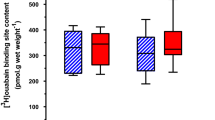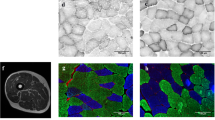Abstract
Ten patients with type 2 diabetes and seven controls were strength-trained with one leg for 30 min three times per week for 6 weeks. The training-induced changes in the protein densities of the Na,K-pump subunits and the Na+/H+ exchanger protein NHE1 were quantified with Western blotting of needle biopsy material obtained from trained and untrained legs of both groups. Training increased the bench press and knee-extensor force by 77±15 and 28±1%, respectively, in the control subjects, and by 75±7 and 42±8%, respectively, in the diabetics. In the control subjects the Na,K-pump isoform α1 was increased by 37% (P<0.05) in trained compared to untrained leg, and in the diabetics the α1 content was 45% higher (P=0.052) in trained compared to untrained leg. For the α2 isoform the corresponding values were 21% and 41% (P<0.05), respectively. The content of the β1 subunit in the control subjects was 33% higher (P<0.05) in trained compared to untrained leg, and 47% higher (P=0.06) in trained compared to untrained leg in the diabetics. Thus, a limited amount of strength-training is able to increase the Na,K-pump subunit and isoform content both in controls and in patients with type 2 diabetes.




Similar content being viewed by others
References
Clausen T (1996) The Na+,K+ pump in skeletal muscle: quantification, regulation and functional significance. Acta Physiol Scand 156:227–235
Djurhuus MS, Henriksen JE, Klitgaard NA (2002) Magnesium, sodium, and potassium content and [3H]ouabain binding capacity of skeletal muscle in relatives of patients with type 2 diabetes: effect of dexamethasone. Metabolism 51:1331–1339
Evertsen F, Medbo JI, Jebens E, Nicolaysen K (1997) Hard training for 5 months increases Na(+)-K+ pump concentration in skeletal muscle of cross-country skiers. Am J Physiol 272:R1417–R1424
Feauvray D (1997) The regulation of intracellular pH in the diabetic myocardium. Cardiovasc Res 34:48–54
Green HJ, Chin ER, Ball-Burnett M, Ranney D (1993) Increases in human skeletal muscle Na+-K+-ATPase concentration with short-term training. Am J Physiol 264:C1538–C1541
Juel C (1998) Skeletal muscle Na+/H+ exchange in rats: pH dependency and the effect of training. Acta Physiol Scand 164:135–140
Juel C (2000) Expression of the Na+/H+ exchanger isoform NHE1 in rat skeletal muscle and effect of training. Acta Physiol Scand 170:59–63
Kato K, Lukas A, Chapman DC, Rupp H, Dhalla NS (2002) Differential effect of etomaxir treatment on cardiac Na+-K+ATPase subunits in diabetic rats. Moll Cell Biochem 232:57–62
Kjeldsen K, Braendgaard H, Sidenius P, Larsen JS, Nørgaard A (1987) Diabetes decreased the Na+-K+ pump concentration in skeletal muscle, heart ventricular muscle, and peripheral nerves of rat. Diabetes 36:842–848
Klitgaard H, Clausen T (1989) Increased total concentration of Na-K pumps in vastus lateralis muscle of old trained human subjects. J Appl Physiol 67:2491–2494
Lavoie l, Levenson R, Martin-Vassallo P, Klip A (1997) The molar ratios of alpha and beta subunits of the Na+-K+-ATPase differ in distinct subcellular membranes from rat skeletal muscle. Biochemistry 36:7726–7732
Madsen K, Franch J, Clausen T (1994) Effects of intensified endurance training on the concentration of Na,K-ATPase and Ca-ATPase in human skeletal muscle. Acta Physiol Scand 150:251–258
McKenna MJ, Schmidt TA, Hargreaves M, Cameron L, Skinner SL, Kjeldsen K (1993) Sprint training increases human skeletal muscle Na+-K+-ATPase concentration and improves K+ regulation. J Appl Physiol 75:173–180
Medbø JI, Jebens E, Vikne H, Refsnes PE, Granvik P (2001) Effect of strenuous strength training on the Na-K pump concentration in skeletal muscle of well-trained men. Eur J Appl Physiol 84:148–154
Putney LK, Denker SP, Barber DL (2002) The changing face of the Na+/H+ exchanger, NHE1: structure, regulation, and cellular actions. Annu Rev Pharmacol Toxicol 42:527–552
Schmidt TA, Hasselbalch S, Farrell PA, Vestergaard H, Kjeldsen K (1994) Human and rodent muscle Na+-K+-ATPase in diabetes related to insulin, starvation, and training. J Appl Physiol 76:2140–2146
Acknowledgements
The financial support from the Danish Natural Research Foundation, the Danish National Research Foundation (J. no. 504-14), the Danish Diabetes Association, the Novo-Nordisk Foundation, The Foundation of 1870, Jacob and Olga Madsens Foundation, and the Danish Medical Research Council is greatly acknowledged.
Author information
Authors and Affiliations
Corresponding author
Rights and permissions
About this article
Cite this article
Dela, F., Holten, M. & Juel, C. Effect of resistance training on Na,K pump and Na+/H+ exchange protein densities in muscle from control and patients with type 2 diabetes. Pflugers Arch - Eur J Physiol 447, 928–933 (2004). https://doi.org/10.1007/s00424-003-1213-x
Received:
Revised:
Accepted:
Published:
Issue Date:
DOI: https://doi.org/10.1007/s00424-003-1213-x




